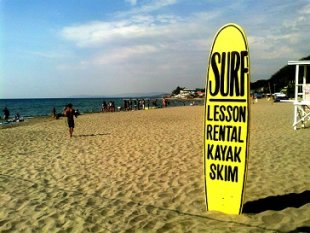PH makes waves in world surfing map
 |
| Elaine Abonal on surfboard |
By Norman Sison,
VERA Files
With over 7,100 islands to choose from, the Philippines is known for its postcard-lovely beaches. Of late, it has been making waves on the world map of surfing.
One Internet site, Wanna Surf (http://www.wannasurf.com/), describes the Philippines as "one of the last surfing frontiers". It lists 35 spots in the country. Fourteen of those are in Siargao Island alone, in the south.
San Juan town in La Union province is the northern Philippines' surfing capital. It is blessed with two surfing seasons — July to October and November to March — when waves spawned by the north swell crest from five to 12 feet.
Singapore-based Anne-Marie Bakker is often in San Juan with her white fiberglass board when she visits her parents' home in San Fernando City, less than half an hour south of San Juan. "Rain or shine, all the time I'm out there," says Bakker, whose cigar company, JB Global, champions Philippine-made cigars abroad and makes custom blends.
If she's not in San Juan, she is out in the water at her beachfront home. "It's hard not to be in the water and the elements when all is so near and tangible," says Bakker, who is half-Filipina and half-Dutch. Her love for surfing gave her an idea to put up a water company, Alon ("wave" in Filipino), also in Singapore.
At Urbiztondo Beach, resorts sport walls decorated with framed photos of big-name surfers and visitors. San Juan Surf Resort, which boasts of several trophies from past international surfing competitions, is home to Filipino-Australian surfer Luke Landrigan, who has flown the Philippine flag in competitions overseas.
"La Union became known abroad because of surfing," says local resident Joy Agustin-Oropesa, who hails from neighboring Bacnotan town, also a surfing spot. "Before surfing became popular, people just went to the beach during the summer. The beach is the province's only tourism attraction."
A Japanese started the surfing trend in La Union in the 1980s. Kazuo Akinaga, who was then working for a surfboard company, read about the Philippines in a magazine. He came, he surfed, he stayed. Today, he lives near the beach in San Juan. His dream: to produce surfboards "made in the Philippines" as most boards are imported and expensive.
Surfing was only what Elaine Abonal calls an "underground sport" when she took up the board 10 years ago. There were hardly any surfing schools and resorts back then, she recalls.
But things have changed. "More surf brands are coming to the Philippines because they know that there is a market here. There are more events and sponsors," says Abonal, who runs Surfista Travels
(http://www.surfistatravels.com/).
Local tourism in La Union is mostly dead during the rainy season. The province is often in the path of typhoons rampaging usually from the Pacific. But typhoons don't scare off everybody. "Surfing addicts are still at it even after a typhoon," says Oropesa. "Most of them are foreigners. The bigger the waves, the better."
This time of the year is for beginners aside from the usual beachgoers escaping the heat, when waves roll in much more gently, just enough to lift swimmers off their feet. But the sea still pounds the off white sand with a crash.
At the north end of Urbiztondo Beach, to avoid ramming swimmers, local tourists — including children — are on surfboards, lined up in the water, taking pointers from local instructors. They wait for that perfect wave and they get a helpful nudge from their instructors. Most wipe out after three seconds. Girls scream in delight as they go down with a big splash.
Aside from targeting surfers abroad, introducing surfing as a fun ride to locals has become a niche market for tour operators. "Surfing takes going to the beach to a whole new and meaningful level because you actually play with the sea or the ocean," says Abonal.
But surfing is not for everybody. It needs a certain skill set, time for travel and money. "Here in the Philippines, surfing is mostly marketed towards the 18-35 age bracket, associating the sport with the easygoing, beach lifestyle so many of us young professionals yearn for," says Cedric Valera, a managing partner at Travel Factor.
Travel Factor (http://www.travelfactor.org/) offers budget weekend tour packages, bringing visitors from Manila for a day of surfing in San Juan. Surfboards and lessons are included. You leave Manila on a Friday midnight in a van. It is a six-hour ride north. You have stopovers in Tarlac and Pangasinan provinces along the way for bathroom breaks and breakfast. You arrive in San Juan between 6 and 7 a.m., and you are on a surfboard by 9 a.m.
There are factors that come into play when selling surfing to local tourists. "A typical Filipino's idea of a beach is one that is safe, calm and suitable for swimming and frolicking around," says Valera. "Filipinos, in general, are scared of the water!"
Also, Filipinos don't like to travel during the monsoon season. However, that is when peak surfing conditions arrive.
As for selling the Philippines to experienced surfers abroad, the main consideration is the inconsistent quality of the waves. Philippine waters are fickle unlike those in Australia, Bali or Hawaii. So, the trick is to know when to visit.
There are things that make up for it, however, such as that world-renowned warm Filipino touch. "Some of our foreigner participants are so delighted with their one-on-one surfing lessons because their instructor is so kind, welcoming and caring compared to the instructors they enlisted in Bali or Australia," says Valera. "The Philippines has world-class surf spots. Couple that with our trademark Filipino hospitality and we've got ourselves something to offer to the world."

surf board sign
No comments:
Post a Comment